Hot tacos!
By Deborah Arriaga W.
This call draws all Mexicans regardless of their social standing and on any occasion.
Tacos are the reference food in Mexico, they are the greatest and tastiest proof that our ancestral corn-based culture cuts through all strata of society. And of how this tortilla-based meal has become a staple in all homes, kitchens, markets and streets of Mexico.
Tacos, Prehispanic Mexican Food
It is a constantly evolving base, flexible, versatile and varied as a roll of dough can be. A tortilla and a filling are enough to give it life. Even then, the filling is optional: air tacos and salt tacos are well-known parts of the culinary panorama.
Taco: a tortilla rolled up with a filling.
Tortilla: the flat cooked dough with which you make a taco.
And what about tortilla’s multifaceted nature: always nourishing, it can also be a plate, a fork and a spoon all rolled into one. Although best eaten freshly made and warm, yesterday’s batch is also very edible but if it sits around more than that starts to go sour.
Tortillas can be made of white, red, blue or yellow corn; they can be mixed with herbs to give it color and flavor, and are also made from wheat flour. Whether soft or crispy, it can be served in many sizes, in pieces, halves, quarters, as long as a whole one remains to make a taco.
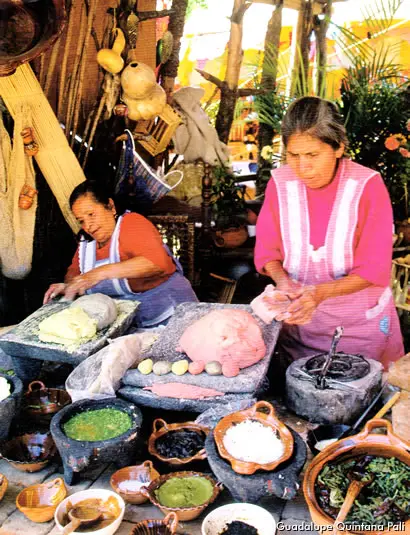
No matter the weather or the occasion, tacos are on everyone’s mind all the time when thinking of food; for a sudden craving or as a midnight snack, an appetizer, an entrée. Any moment is the right moment, day or night. If you are not hungry or you want to indulge, maybe both, any excuse is good to scarf down a taco.
Because scarfing down a taco means eating: just eating or eating a taco as such. There is infinite ways, postures and places to eat tacos: squatting, sitting or strolling. They can be eaten next to a sizzling grill or a burning flame, at a table, at home or in a restaurant (be it classy or classless, for, after all, tacos require little protocol).
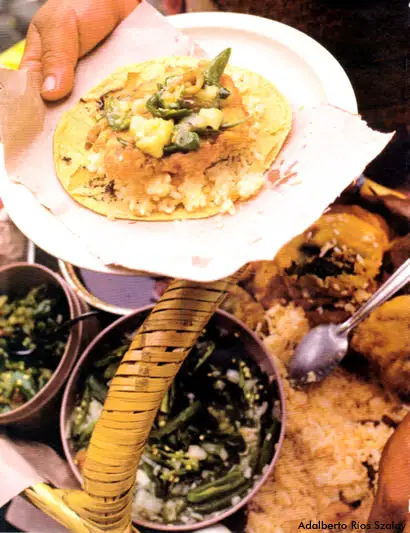
They can be consumed standing at the proverbial taco stand or at a reception, openly or surreptitiously, quickly or calmly, anywhere in villages, cities, countryside, jungle, high sierra or by the beach in Puerto Vallarta or any other Mexican destination.
Eating them requires only one condition; tacos must be eaten with your hands. It doesn’t matter if you use two fingers, three or all of them: by hand, it must be. Anyplace where there is a rolled up tortilla, whether filled or empty, you have a taco! Using a knife and fork is out of the question and gauche.
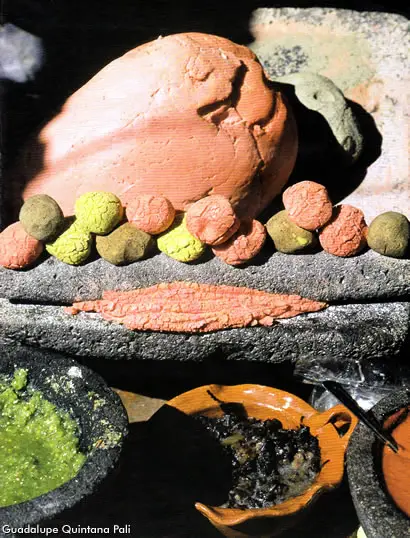
Tacos are fortunate, but more so are those who eat them. Their universe is infinite with no restrictions on content or context. They can be accompanied or presented to anyone and with anything. All edible matter is fair game for the taco, it just has to be placed properly so that it does not squirt or dribble out.
Taco names vary according to their origin, filling, and preparation. Here is a partial list of some of the most famous tacos:
- Pork, beef, chicken, goat, including their tripe and sweetbread; in chops, steaks, pork rind, fajitas, made with lean meat or headcheese, spicy sausage, venison sausage, pickled rind, feet, stomach, cheek, snout, tongue, brain, mountain oysters, intestines and heart, or whatever you fancy.
- They can be made from fish and seafood such as shrimp, octopus, crab, chopped up raw sea bass, sea minnows and sea slugs, and also ground lobster and manta ray.
- Insects, dead and alive: holm oak beetles, grasshoppers, ants and escamoles (their roe), maguey worms and ahuauhtle (mosquito caviar).
- Vegetables, grains, flowers, mushrooms, nopal (cactus leaves), quelites (leafy greens), corn, pumpkin flower, colorín (hibiscus flower), and the tortilla taco, an authentic and tasty redundance.
- Stews cooked as taco filling, such as shredded meat salad, mole (spicy chocolate sauce), pipian (ground pumpkin seed sauce), chilorio (spicy meat), moronga (blood sausage), cochinita pibil (pork in annato seed sauce), Mexican style rice, potatoes and spicy sausage, pork rind in green or red chile sauce, ranch style or refried beans. And just about anything that may strike your fancy… even leftovers.
- Rolled up and filled with nothing but air, such as the Yucatan codzito.
- Or you can try tacos de muerte lenta (slow death), filled with scraps of dubious origin.
- Or the traditional tacos, charcoal broiled or grilled.
- Tacos al pastor, Arab or Mediterranean influenced, good at any time, especially at night, after the movies or a concert, flavored with coriander, onion, and pineapple.
- Hard-shell tacos, fried in oil, and the flautas (flutes), their long version.
- The suadero tacos, great to top off a wild night out in town.
Tacos sudados, sweaty tacos… just imagine how they’re made!
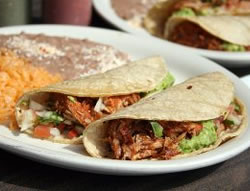
But tacos are almost never served alone. They most often come with chile, that other Mexican icon. Whether it is served alone – in any of its multiple varieties – or in a red, green, Mexican, or borracha sauce – the chili pepper is an ideal mate for the taco. However, luckily one can taquear (eat tacos) without it, for although chile is a common companion, it is not indispensable for eating tacos.
Tacos can also be dressed up with avocado slices, guacamole, red, white and green onions, shredded cabbage or lettuce, cheese and, yes, even cream, a very important ingredient for many tacos.
But the taco is not only our food, it is also our language: to heap cream on your taco is to preen oneself, brag, be overwhelmingly self-congratulatory. It surpasses the essence of simply eating a taco.
But it’s alright to give yourself a taco, to puff yourself up if the moment’s right and it’s done within an acceptable range of modesty. And how nice it can be to give yourself an eye taco, an eyeful of a strolling beauty, handsomeness; to watch the bulls from the front row.
As for myself, I’m about to finish my tongue taco, And what about you, how would you like your taco?
WHEREVER YOU ARE IN PUERTO VALLARTA OR SOMEWHERE ELSE IN MEXICO, EAT TACOS AND YOU WILL SEE HOW GOOD THEY TASTE AND HOW QUICKLY YOU LEARN ABOUT THEM.
Tacos 101 for Puerto Vallarta Visitors
By Joseph Kandoll
The humble taco was one of the first foods of Mexican origin to gain widespread popularity north of the border. Today, crispy taco shells filled with spiced ground beef, grated cheddar cheese, and chopped lettuce and tomato have become common fare in fast-food restaurants and school cafeterias. Yet, visitors to Mexico will find something quite different when ordering a taco here. Probably the biggest surprise will be that the shell is soft, rather than crispy, but the differences don’t stop there. Everything from the meat to the garnishes, to the sauces, will be novel to the uninitiated.
And even within Mexico, styles of tacos vary from region to region. In the northern part of the country, the large flour tortillas, de harina, are more common, while in Puerto Vallarta and the southern part of the country in general, smaller corn tortillas, de maiz, are the rule. And even the corn tortillas vary, with sizes ranging from 3” to 6”. When using the smaller size, a couple is usually needed per taco.
The meat fillings also vary by region. Common in Puerto Vallarta are tacos of carne asada, slices of beef grilled over mesquite coals; arrachera, a spicier version from the north; carnitas, pork cooked in a style native to our state of Jalisco; and al pastor, sliced marinated pork stacked on a spit. Carnitas, a pig that has been cut up and cooked in lard with orange rind, is one way to be sure every part of the animal is used. For the squeamish, asking for maciza will ensure that your filling is just a nice piece of pork. The more adventurous may want to try buche, or cheeks, orejas, or ears, and corazon, or heart. Tacos al pastor, or shepherd’s tacos, are made from slices of pork stacked on a vertical spit called a trompo, or top, which turns slowly in front of a gas flame. Originally brought to Mexico by Lebanese immigrants, this style of meat is then expertly shaved off by the taquero, or taco vendor, with a slice or two of pineapple for the special flavor it imparts.
Once the choice of meat has been made, it’s time for garnishes and sauces. The taquero may automatically add the garnishes or you may choose from among sliced radishes, cucumbers, cabbage, cilantro, chopped onions, grilled green onions and the ubiquitous lime wedges. Then come the salsas, or sauces. There will be several choices, depending on which meat you choose. If you’re unsure, try just a little at first. The flavors and spiciness vary and “liquid fire” could be the result. The dark red salsa is made from small, dried red chilies, and can be quite hot. The textured green salsa is made from green tomatillos, and may be less spicy. The light green salsa is made of avocados and has a flavor similar to guacamole. The milder red, green and white salsa, called pico de gallo, or rooster’s beak, in some areas, is called salsa Mexicana in Jalisco because of the colors of the tomato, cilantro and onion also are the colors of the Mexican flag.
Tacos can be found practically everywhere, from established restaurants to taquerías, or permanent taco stands, to puestos, or the ambulatory carts that set up in the same place each morning. Should you be nervous about standards of cleanliness at the puestos? Maybe not nervous, but definitely aware. In making your choices, consider advice from locals, who will recommend the places they frequent, happy to send more business to their favorite stand. If there’s no one to ask, check around for a stand that has a lot of customers. Once again, the local people know where to go. Check whether there is water available for washing hands and utensils. Also, check how the money is handled. If there isn’t a person specifically designated to handle the money, a plastic bag or glove should be doned to give back the change, and then removed before touching the food. However, one advantage of eating at a taco stand rather than a traditional restaurant is that everything is prepared right in front of you so you can observe what goes into it and be sure that it is fresh.
Remember, as you travel in a country where things may be new to you, that part of the adventure is trying new things or variations on familiar things. When it comes to food, you can still be adventurous, just keep your senses about yourself.
Last Updated on 09/11/2021 by Puerto Vallarta Net



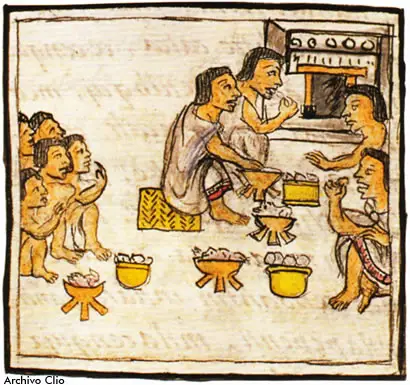




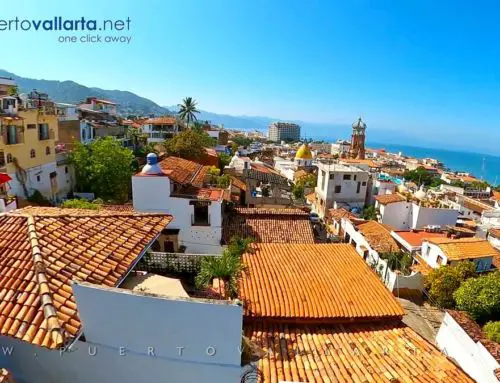



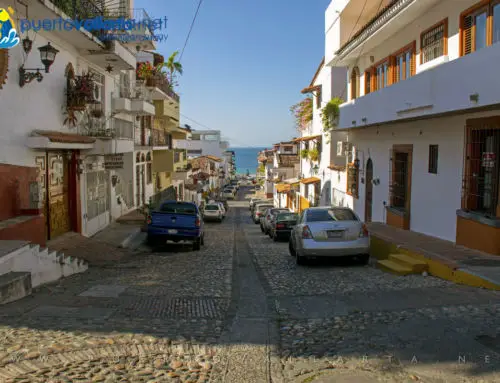
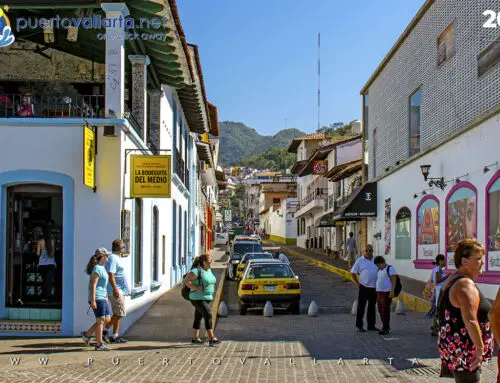

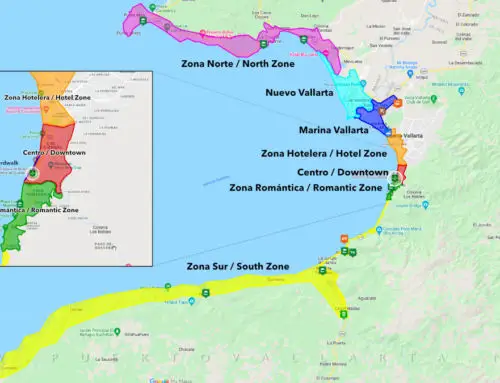
Leave A Comment